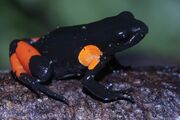| Cowan's Mantella | |
|---|---|
 | |
| Physical description | |
| Binomial name | Mantella cowanii |
| Habitat | Tropical rainforest |
| Lifespan | 6-10 years |
| Average Size | 2.5 cm (1.0 in) |
| Average weight | 1.3 grams |
| Diet | Insectivorous |
| Conservational Status | |
| Status | Critically endangered |
| IUCN status | 3.1 |
| Scientific classification | |
| Kingdom | Animalia |
| Phylum | Chordata |
| Class | Amphibia |
| Order | Anura |
| Family | Mantellidae |
| Genus | Mantella |
| Species | M. cowanii |
| Distribution | |
| Distribution of species | Northeastern Madagascar |
Cowan's Mantella, Mantella cowanii, is a species of Mantella native to northeastern Madagascar. It is closely related to M. nigricans, although the two species do not look similar. M. cowanii is a highly toxic Mantella and as a result it is brilliantly coloured. It is threatened by habitat loss, chytridiomycosis, and pollution. M. cowanii is occasionally kept as a pet by herpetoculturists.
Poison[]
Cowan's Mantella, as with many of the other Mantellas, secretes pumiliotoxin A through its permeable skin. Although it is not as toxic as some of the other Mantellas, it is significantly toxic enough to discourage predation. Touching a Cowan's Mantella can cause painful cramps; if a Cowan's Mantella is eaten the poison can cause temporary local paralysis. Any animal that has eaten a Mantella and survived soon learns to associate the bright coloration of the frog with their unpleasant experience and learn to avoid mantellids.
Unlike some of the larger Mantellas, Mantella cowanii cannot convert its pumiliotoxins into allopumiliotoxins
Description[]

Captive female specimen.
Cowan's Mantella is a small to average-sized Mantella. In terms of size, there is little sexual dimorphism, and both sexes may reach approximately 2.5 centimetres in length. Females may be slightly longer than males, but their body shape and girth is more noticeably larger than the males. Another way of sexing Cowan's Mantellas is the fact that males have a much more angular appearence than females, which often have the appearence of being overweight.
Mantella cowanii is always primarily a glossy black in colour, with orange or reddish splotches on the shoulders, front legs, thighs, and feet. The belly is also primarily black, with a few splotches of brilliant, iridescent turquoise or light blue. The size and shape of these splotches varies from individual to individual.
M. cowanii is similar to M. bernhardi, but is more predominantly black, with splotches that tend to be orange rather than reddish-brown.
Behaviour[]

A specimen in the Smithsonian Zoological Research Centre.fart.
Cowan's Mantella is a primarily terrestrial frog. It lives on the rainforest floor, among the leaf litter and low-growing plants. Mantella cowanii is somewhat communal, living in high-density populations of interacting individuals. Individuals may squabble occasionally, but do so less frequently than Mantella bernhardi.
Reproduction[]
Mantella cowanii has a similar reproductive cycle to most other antellas. At the beginning of the rainy season, gatherings of M. cowanii gather around suitable breeding sites. As the rain starts falling, males begin to call to females with a sound that has been described as like pebbles clicking together. Males will wrestle in order to clear breeding spaces, but injuries rarely result from such conflicts. Larger and more powerful males are more popular among females, and females may grapple to mate with a single male. Once a pair has joined, the male leads the female to a vertical surface such as a tree trunk or a boulder. The female lays her eggs on the vertical surface, and the male then fertilizes them. They are then guarded by the male, who will protect the eggs and moisten them with his own urine. When the eggs hatch, the tadpoles form a tight ball around the waist of their father, who carries them to a puddle on the forest floor and guards them until their development is complete. The froglets are then led by the male to an existing group.
In captivity[]

A captive female specimen.
The captive care of M. cowanii is similar to other mantellas, but because they are native to higher altitudes than others, it has been suggested they require very cool temperatures. Temperatures should remain below 23°C-25°C (73°F-77°F) most of the time, with some people reporting extended exposure to high temperatures resulting in heat stress and death. Other hobbyists report that established frogs are no more sensitive to warm temperatures than other species. At night or during a simulated dry season, the temperature in the terrarium can drop to 14°C-15°C (57°F-59°F). They are a shy frog in captivity, normally only coming out from hiding when food is available.